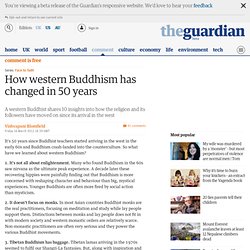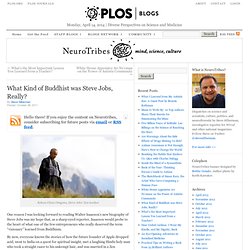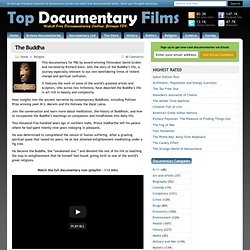

Face to faith: How western Buddhism has changed in 50 years. It's 50 years since Buddhist teachers started arriving in the west in the early 60s and Buddhism crash-landed into the counterculture.

So what have we learned about western Buddhism? 1. It's not all about enlightenment. Many who found Buddhism in the 60s saw nirvana as the ultimate peak experience. A decade later these recovering hippies were painfully finding out that Buddhism is more concerned with reshaping character and behaviour than big, mystical experiences. 2. 3. 4. 5. 6. 7. 8. 9. 10. What Kind of Buddhist was Steve Jobs, Really?
Hello there!

If you enjoy the content on Neurotribes, consider subscribing for future posts via email or RSS feed. Kobun Chino Otogawa, Steve Jobs' Zen teacher. One reason I was looking forward to reading Walter Isaacson’s new biography of Steve Jobs was my hope that, as a sharp-eyed reporter, Isaacson would probe to the heart of what one of the few entrepreneurs who really deserved the term “visionary” learned from Buddhism.
By now, everyone knows the stories of how the future founder of Apple dropped acid, went to India on a quest for spiritual insight, met a laughing Hindu holy man who took a straight razor to his unkempt hair, and was married in a Zen ceremony to Laurene Powell in 1991. I was curious how Jobs’ 20-year friendship with the monk who performed his wedding — a wiry, swarthily handsome Japanese priest named Kobun Chino Otogawa — informed his ambitious vision for Apple, beyond his acquiring a lifetime supply of black, Zen-ish Issey Miyake turtlenecks.
Flowers at Tassajara. 'Westerners associate Buddhism with therapy' We are perfect Buddha Mind. The Buddha. This documentary for PBS by award-winning filmmaker David Grubin and narrated by Richard Gere, tells the story of the Buddha’s life, a journey especially relevant to our own bewildering times of violent change and spiritual confusion.

It features the work of some of the world’s greatest artists and sculptors, who across two millennia, have depicted the Buddha’s life in art rich in beauty and complexity. Hear insights into the ancient narrative by contemporary Buddhists, including Pulitzer Prize winning poet W.S. Merwin and His Holiness the Dalai Lama. Join the conversation and learn more about meditation, the history of Buddhism, and how to incorporate the Buddha’s teachings on compassion and mindfulness into daily life. Two-thousand-five-hundred years ago in northern India, Prince Siddhartha left his palace where he had spent twenty-nine years indulging in pleasures.
He was determined to comprehend the nature of human suffering. Watch the full documentary now (playlist - ) Buddhists’ Delight. If you really want to hear about it (to borrow a phrase from Holden Caulfield), I was on retreat.

Perhaps I should say, I was in retreat, from a frenetic Manhattan life, hoping to find the balance and harmony that have formed the basis of the Buddhist tradition ever since Siddhartha Gautama discovered enlightenment around 2,500 years ago while sitting under a Bodhi tree in Northern India. The fundamental insight of the Buddha (the Awakened One) is this: life consists of suffering, and suffering is caused by attachment to the self, which is in turn attached to the things of this world. Only by liberating ourselves from the tyranny of perpetual wanting can we be truly free. Not that I am ready to renounce this world, or its things.
“I am still expecting something exciting,” Edmund Wilson confided in his journal when he was in his mid-60s: “drinks, animated conversation, gaiety: an uninhibited exchange of ideas.” Many converts are what Thomas A. So who are these — dare I coin the term? Buddha Sculpture Invites Reflection, and Instagram Photos.